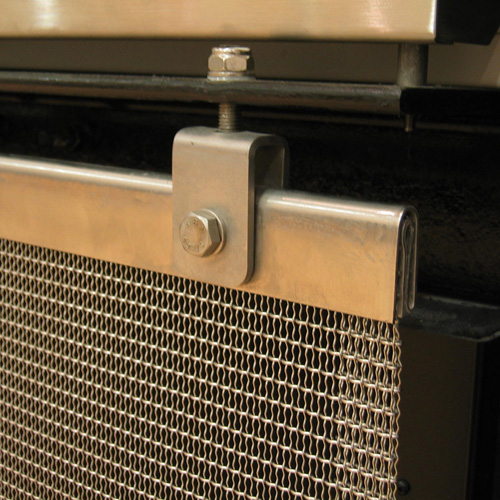How To Purchase Architectural Mesh? (Forms, Cost, and Availability)
Architectural mesh is one of the most unique and versatile materials that is designed to stand the test time. It provides qualities, such as natural ventilation and fall protection, that keep visitors safe.
This is why architectural mesh is perfect for use on a structure inside and out.
No matter what needs your project demands, there is always a need to have your material prepared in a way that facilitates the design process. This is why you must buy your mesh in the correct form.
Here at W.S. Tyler, our team of architectural experts have over 20 years of experience and are here to guide you through the many ways you can buy architectural mesh solutions.
With that, this article will establish the three form factors in which architectural mesh is available, how each form affects cost, and how the forms affect the availability of certain mesh profiles.
Architectural Mesh Cut-To-Size Pieces
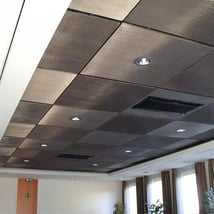 Cut-to-size architectural mesh is best defined as mesh that the mesh supplier cuts based on dimensions and quantities you specify. Most suppliers can also provide dimensions and quantities after receiving shop drawings of a project.
Cut-to-size architectural mesh is best defined as mesh that the mesh supplier cuts based on dimensions and quantities you specify. Most suppliers can also provide dimensions and quantities after receiving shop drawings of a project.
That said, cut-to-size pieces are ideal for use on a variety of applications. These include infill panels, guardrail panels, elevator cabinets, railings, and interior wall panels.
The biggest disadvantage to cut-to-size architectural mesh is that the pieces get cut out from an existing roll of mesh. As a result, there is a lot of waste of material meaning you are paying for more material than you need.
However, this is the case for most if not all materials that get cut to fit a custom dimension.
Architectural Mesh Rolls
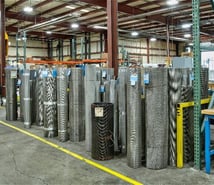 Architectural mesh rolls are sheets of mesh that get wrapped around a cardboard tube and placed in a shipping container. Depending on the dimensions and mesh profile, rolls are available in increments of 100 feet up to 1,000 feet.
Architectural mesh rolls are sheets of mesh that get wrapped around a cardboard tube and placed in a shipping container. Depending on the dimensions and mesh profile, rolls are available in increments of 100 feet up to 1,000 feet.
Mesh rolls are perfect for those who have experience working with architectural mesh and have the capability to cut the mesh. This can prove to be one of the more cost-effective ways to put architectural mesh in place.
Now, because you are responsible for any further cutting or fabrication once the mesh arrives, labor costs will increase. You must also ensure you and your staff have the training needed to work with mesh.
Note: The integrity of its square openings is prone to compromise when mishandled.
Ready To Install Architectural Mesh
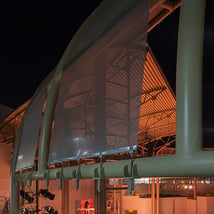 Ready to install mesh is architectural mesh that is woven, cut, and prepped by the mesh supplier.
Ready to install mesh is architectural mesh that is woven, cut, and prepped by the mesh supplier.
As architectural mesh must get handled with care, this is the safest method. This is because it arrives in a state in which the installers simply need to attach it to the structure.
For example, if you are integrating a tensioned system, ready to install mesh will come with the wire mesh panels with flat tension profiles, mounting hardware, and any intermediate tubing needed.
That said, ready to install mesh is perfect for all tensioned applications. This includes facades, canopies, acoustic sound panels, and more.
The biggest set back when working with ready to install mesh is that it’s a specialty product. This means a lot of contractors are unaware of the steps that go into the installation of tensions mesh systems.
The mishandling of tensioned systems often results in broken wires, bent panels, and a loss in lustrous quality.
NOTE: No matter how you buy your wire mesh solution, the mesh type can limit the dimensions. Cable mesh can go up to 13 feet wide whereas woven wire mesh can go to 10 feet wide.
For more information about how these mesh types compare, refer to our article: Cable Mesh vs Wire Mesh: Picking the Best Architectural Solution.
What Are the Cost Differences?
Despite the form of the architectural mesh you select, most of the cost comes from the material itself. With that, the price between cut-to-size pieces and ready to install panels is not as much as you would think.
This means that you can expect to see a price range of $20 to $25 per square foot.
That said, wire mesh rolls can be 10% less expensive. This means that the price of a mesh roll can sometimes reach prices below the $20 low-end.
Of course, the price depends on factors such as the mesh specifications and roll length.
To learn more about the cost of architectural mesh, refer to our article: How Much Does Architectural Mesh Cost?
Availability
When selecting which method to buy your architectural mesh, it is important to keep profile limitations in mind. In other words, certain mesh profiles are limited to certain forms.
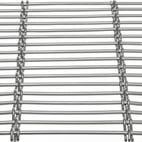
Some mesh profiles can't get used in a tensioned system and are only available in cut-to-size pieces or rolls.
For example, DOKA-BARRETTE 8915 can not get used for tensioned applications. This goes for some of the specialty mesh profiles and most of the fine mesh profiles.
On the other hand, all mesh profiles that apply to tensioned systems can get applied to any application. Thus, they are available in all three forms discussed in this article.
Optimize Your Architectural Design Process
Whether you buy your mesh in cut-to-size pieces, rolls, or as ready to install panels, selecting the right material form factor is vital to an efficient design process.
If you need a project done quickly and have an adequate budget, cut-to-size or ready to install pieces are the ideal solution. If you are looking for cost savings and have worked with architectural mesh in the past, mesh rolls will work best.
That said, once you have the right material, you should know what to expect moving forward to develop a schedule based on lead times and installation duration.
Having worked in the field of architectural design for more than 20 years, W.S. Tyler is here to guide you towards an architectural mesh solution that will optimize your design process.
To gain more insight into what to expect next, take a look at our article: What To Expect When Purchasing Architectural Wire Mesh.
About Ronnie Brown
Ronnie is the Content Writer for W.S. Tyler and has four years of experience as a professional writer. He strives to expand his knowledge on all things particle analysis and woven wire mesh to leverage his exceptional writing and graphic design skills, creating a one-of-a-kind experience for customers.

